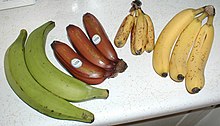Should diabetics eat bananas?
If you are a regular on the net you must have seen those ubiquitous ads picturing bananas in varying degrees of ripeness. If you click on one of these ads it takes you to a sales page selling a diet program. As someone interested in how to prevent pre-diabetes or borderline diabetes, I want to know if eating bananas is good or bad for the condition.
Should diabetics eat bananas? A resounding yes . . . . is the immediate response. However this response should contain a few caveats. Bananas are one the most easily accessible fruits — from the local corner shops to supermarkets — that contain many healthy nutrients but like all foods it should be eaten in moderation.

The banana fruit comes in a variety of forms ranging in sizes from approximately three inches to 9 or more inches in length. When eaten as a green fruit it is mainly starch and has a starchy taste. In fact in some cultures green bananas are grated and used to make a flour that’s used in making bread, puddings, pancakes and other flour like products.
In the ripen state it has a sweeter taste because of the higher sugar concentrations. This is the form most consumed by the general public.
In my country of Jamaica, green bananas are a staple used in many recipes and is eaten at breakfast, lunch and dinner.
Nutritional makeup of bananas
The following table shows the nutritional make up of bananas. Please note that the nutritional values varies based on the stage of ripeness of the fruit as well as its size.
An average size banana (about 126 grams) is considered to be one serving. One serving of banana contains 110 calories, 30 grams of carbohydrate and 1 gram of protein. Bananas are naturally free of fat, cholesterol and sodium.
Bananas provide a variety of vitamins and minerals:
- Vitamin B6 – .5 mg
- Manganese – .3 mg
- Vitamin C – 9 mg
- Potassium – 450 mg
- Dietary Fiber – 3g
- Protein – 1 g
- Magnesium – 34 mg
- Folate – 25.0 mcg
- Riboflavin – .1 mg
- Niacin – .8 mg
- Vitamin A – 81 IU
- Iron – .3 mg
The recommended intake of potassium for adults is 4700 milligrams per day. Although bananas are known to be a good source of potassium, there are other sources with higher content of this nutrient such as bell peppers, lima beans, dark leafy greens, fish (salmon, tuna) and avocados.
How does bananas affect blood glucose?
As a general rule, diabetics should limit their consumption of carbohydrates to no eat more than 45 grams at each meal and fruits and veggies should be a main source of those carbs. A medium banana which is about 7 to 8 inches in length has approximately 27 grams of carbs. In other words eating an average size a banana will raise your level of glucose. However if you can limit your intake of other carbs it is perfectly ok to have a banana each day. Remember, the riper the fruit the more sugar it will have.

Wow, fantastic blog structure! How long have you ever been blogging
for? you make blogging look easy. The whole look of your site is
magnificent, let alone the content!